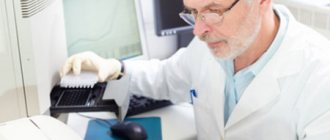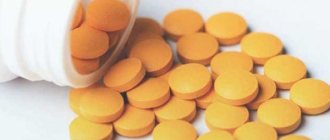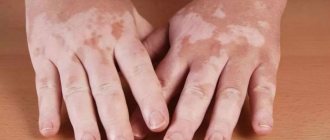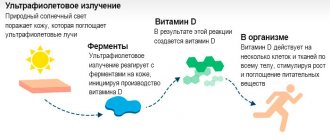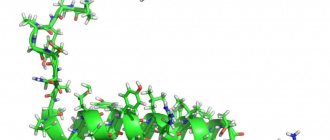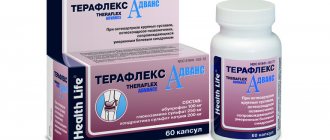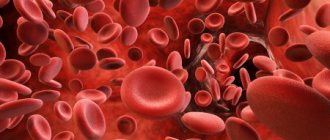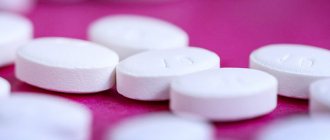How it manifests itself
Against the background of hyperandrogenism, irreversible processes can start in the ovaries, which can lead to the formation of cysts and densely structured capsules around the ovaries.
Often, with excessive androgen production, anovulation is observed - a process in which the egg does not leave the ovary during menstruation. This phenomenon leads to infertility or miscarriage in early pregnancy.
But hyperandrogenism also manifests itself in the form of disturbances in the cyclicity of menstruation. If the pathology is congenital, the first menstruation may be delayed for several years. In this case, the cyclicity may be disrupted, sometimes the discharge becomes too abundant.
Due to excessive production of the male hormone, a woman experiences increased hair growth where it should not be (hirsutism).
Often such endocrine disorders are accompanied by obesity; a woman is at risk of developing diabetes mellitus.
When are tests prescribed, and how to take them?
In order to determine whether androgens in a woman’s body are elevated, she needs to undergo a full examination in a clinic. After collecting a medical history and examination, a gynecologist or endocrinologist will refer the patient for tests. Blood for androgens is donated from a vein.
In order to obtain the most reliable results, the analysis should be taken from the 3rd to the 5th or from the 8th to the 10th day of the cycle. The day before the test, you should try to avoid stress, avoid sexual intercourse and physical activity. Before being tested for elevated androgen levels in women, the patient needs to rest well, calm down and not smoke for at least two hours.
Before taking tests, you need to avoid stress, try to get a good rest and sleep.
If the results show an excess or deficiency of male hormones, tests can be repeated in the same laboratory to confirm the diagnosis and exclude medical errors. However, under no circumstances should you despair. Bad tests are not a death sentence, it’s a reason to take your health seriously.
You can make an appointment with a doctor and get advice from a competent specialist here https://45plus.rf/registration/.
Types and causes of the syndrome
Considering the causes and mechanism of occurrence of the disease, hyperandrogenism is classified into the following types:
- ovarian;
- adrenal;
- mixed;
- central;
- peripheral;
- transport.
The primary reasons for an increase in androgen concentration in a woman may be:
- adrenogenital syndrome (insufficient production of C21-hydroxylase by the ovaries);
- polycystic disease;
- neoplasms;
- thyroid or liver dysfunction;
- hormonal therapy or taking oral contraceptives.
All this is fraught with changes in metabolic processes and an increase in the concentration of male sex hormones.
Hyperandrogenism of ovarian origin
The cause of the disease can be both genetic and acquired factors.
This form of pathology is characterized by a sharp development and unexpected manifestations of symptoms. In this case, under the influence of aromatase, estrogen is transformed into androgen.
In addition, hyperandrogenism of ovarian origin can cause the growth of hormone-dependent neoplasms.
Hyperandrogenism of adrenal origin
This pathology is caused by adrenal tumors and androgenital syndrome. More often, the syndrome is caused by an abnormal structure of the gene that is responsible for the formation of C21-hydroxylase.
During pregnancy or during stressful situations, the deficiency of the enzyme is not covered. As a result, the manifestation of androgenital syndrome worsens.
With adrenal hyperandrogenism, the cyclicity of menstruation is disrupted or they are completely absent.
Hyperandrogenism and infertility
Many doctors note that pathology and infertility are interconnected. With increased production of male hormones, the ovaries transform, and the environment becomes favorable for the formation of cysts. In this case, even a mature egg cannot leave the ovary, which makes fertilization impossible.
Some women still manage to get pregnant naturally, but in the early stages a spontaneous miscarriage occurs or the embryo freezes and does not develop.
Hyperandrogenism is a complex anomaly that needs to be treated with medications. Only after undergoing high-quality therapy and with timely detection of the pathology can a woman have a chance to become pregnant and give birth to a child.
Causes of the disease
Both the ovaries and the adrenal glands can produce excess androgens. In addition, excess androgens can appear as a result of metabolic disorders.
Adrenogenital syndrome is the most common cause of an increased amount of male sex hormones.
Hyperandrogenism is congenital, or this disease occurs due to diseases (including tumors) of the pituitary gland, which is the main endocrine gland located in the brain. In the presence of neuroendocrine syndrome (dysfunction of the pituitary gland and hypothalamus), signs of hyperandrogenism are accompanied by a significant increase in body weight.
In addition, the cause of the disease may be the presence of an adrenal tumor. As the number of cells that produce androgens increases, the number of these hormones also increases significantly.
Treatment of hyperandrogenism
When treating this disorder, a woman’s hormonal levels are corrected and the root cause of the disease is eliminated. Recommendations depend on the patient’s age, severity of pathology and other associated complications.
If a woman is infertile, she needs ovulation stimulation, IVF, and laparoscopy.
Conservative therapy
Treatment of hyperandrogenism with conservative methods boils down to the following actions:
- a diet in which a woman consumes fewer calories than her body uses;
- sport;
- taking medications based on female sex hormones;
- prescribing drugs that blunt the production of androgens;
- use of progesterone.
In addition, therapy should be supplemented with treatment of concomitant diseases of the liver and thyroid gland, and it is also worth eliminating adrenogenital syndrome.
Application of traditional medicine
In addition to drug therapy, hyperandrogenism can be treated with traditional methods.
The most important thing that is required from the patient is to bring her lifestyle to a healthy norm.
The following infusions from traditional medicine are very popular:
- radios;
- nettle;
- red brush;
- upland uterus in combination with red brush;
- licorice and marina root;
- dandelion root.
High efficiency can also be achieved by replacing regular tea with herbal infusions. It is especially good to combine mint, milk thistle and thistle.
Diagnostics
Diagnosis of androgens includes collecting the patient’s complaints, medical history and conducting various tests. This makes it possible to detect the very fact of a hormonal surge and identify the primary source of the pathology.
Carrying out analyzes involves determining:
- total testosterone;
- luteinizing and follicle-stimulating hormone;
- 17-hydroxyprogesterone;
- SHBG (sex hormone binding globulin);
- DHEA-S (dehydroepiandrosterone sulfate).
To diagnose the disease, an ultrasound of the pelvic organs, tomography and some other studies are additionally prescribed.
Consequences for the body
Since increased production of androgens affects not only the appearance of women, but also reproductive function and general health, an increase in male hormone levels can lead to the following consequences:
- the girl loses the opportunity to become pregnant;
- the risk of developing cancer increases;
- gynecological abnormalities are actively progressing;
- Women are at risk of obesity and become prone to heart attacks and strokes.
To avoid such complications, you need to undergo regular examinations with a gynecologist.
Prevention measures
Prevention is as follows:
- regular (2-3 times a year) visits to the gynecologist;
- minimizing increased stress (both psycho-emotional and physical);
- giving up bad habits (smoking, alcohol abuse);
- balanced and rational diet: give preference to foods rich in fiber and avoid fried and spicy foods, as well as canned foods;
- timely treatment of diseases of the liver, thyroid gland and adrenal glands.
Is it possible to conceive and bear a healthy child with this diagnosis? Yes, it is quite. But given the increased risk of miscarriage, this is not easy to do. If you learned about the problem at the stage of pregnancy planning, you should first normalize your hormonal levels. In the case where the diagnosis has already been made “after the fact”, the tactics of further therapy (which, we note, is not always necessary) will be determined by the attending physician, and you will only have to unconditionally follow all his recommendations.
Related links:
What is bone tissue hydroxyapatite? Loss of dental bone tissue - what is it? Functions of bone tissue in the body. Deformation of the bone tissue of the lower jaw. Destruction of dental bone tissue - what is it?
Hyperandrogenism and its types
Hyperandrogenism is a fairly common disease that causes amenorrhea and infertility. This pathology is caused by changes in the secretion and metabolism of androgens. In 45-77 percent of patients, the disease causes cycle disruption. In 60-75 percent of cases, the pathology leads to endocrine infertility, and in 20-30 percent - to miscarriage. There are such types of disease:
- ovarian hyperandrogenism;
- adrenal;
- central;
- mixed;
- peripheral.
The central and peripheral varieties of the disease are quite rare. The first of them is caused by damage to the hypothalamus and pituitary gland, and the second by a hereditary factor or diabetes mellitus.
Adrenal genesis and mixed form
Adrenal hyperandrogenism is caused by excessive levels of dehydroepiandrosterone and 17a-hydroxyprogesterone. This pathology causes miscarriage in thirty percent of patients. Women with adrenal hyperandrogenism often exhibit signs of masculinization. This disease requires precise diagnosis, since adrenogenital syndrome in most cases is mild. Most often, the pathology is associated with insufficient aldosterone levels. Hormones are produced in the adrenal cortex and are synthesized by glucocorticoids. If such enzymes are absent, they are replaced by androgens. Adrenogenital syndrome is basically a hereditary condition in which menstruation begins much later than in other women; Excessive acne and pigmentation appear on the body and face. Patients are distinguished by a masculine figure and hypoplasia of the mammary glands. If we talk about the genitals, individuals with this pathology have a small uterus and a hypertrophied clitoris.
Adrenal genesis and mixed form
Adrenal hyperandrogenism is caused by excessive levels of dehydroepiandrosterone and 17a-hydroxyprogesterone. This pathology causes miscarriage in thirty percent of patients. Women with adrenal hyperandrogenism often exhibit signs of masculinization. This disease requires precise diagnosis, since adrenogenital syndrome in most cases is mild. Most often, the pathology is associated with insufficient aldosterone levels. Hormones are produced in the adrenal cortex and are synthesized by glucocorticoids. If such enzymes are absent, they are replaced by androgens. Adrenogenital syndrome is basically a hereditary condition in which menstruation begins much later than in other women; Excessive acne and pigmentation appear on the body and face. Patients are distinguished by a masculine figure and hypoplasia of the mammary glands. If we talk about the genitals, individuals with this pathology have a small uterus and a hypertrophied clitoris.
Even more interesting:
Unidox for acne
Ovarian inflammation symptoms
The mixed form is considered the most heterogeneous in terms of the amount of hormones in the blood and clinical signs. Among patients with this disease, this type of pathology is considered the most common. This disease is accompanied by an increase in the blood level of dehydroepiandrosterone with a moderate increase in LH, slight hyperprolactinemia and a clear increase in the amount of 17-OP and 17-CS. The clinical symptoms of the disease are the same as in cases with adrenal and ovarian hyperandrogenism. On ultrasound, this form manifests itself in typical polycystic ovaries and the presence of small cysts. The cause of the mixed form is most often experienced severe stress and head trauma.
Excess adrenal androgens
Your adrenal glands produce about 50% of your total androgens. You can estimate how much androgens are coming from the adrenal glands by measuring the hormone DHEA-s in a blood test. If you have high levels of adrenal androgen (DHEAS) , but normal levels of testosterone and androstenedione , then the source of hyperandrogenism is the adrenal glands.
Causes of excess production of androgens by the adrenal glands
One cause of adrenal androgen excess is the genetic condition of non-classical form (or late stage) congenital adrenal hyperplasia (NF CAH). It accounts for up to 9% of cases of androgen excess and is often misdiagnosed as PCOS. The fact is that the symptoms in women with CAH and PCOS are identical: manifestations of hyperandrogenism, menstrual irregularities, infertility. Differential diagnosis of PCOS and NF CAH is difficult. If the basal level of 17-OH progesterone in the blood is elevated, then a test is performed with an analogue of adrenocorticotropic hormone (ACTH) : it increases the plasma concentration of 17-OH progesterone, and if it exceeds 30 nmol/l, then a diagnosis of a non-classical form of congenital cortical hyperplasia can be made adrenal glands However, this test and its indications have not yet been unified. The molecular genetic method of examination is becoming more and more widespread in practice: identifying mutations in the 21-hydroxylase gene.
Another cause of excess synthesis of adrenal androgens is increased prolactin .
Treatment of congenital adrenal hyperplasia
Represents a low dose of hydrocortisone to suppress adrenal androgen production (symptomatic treatment). Interestingly, low-dose hydrocortisone has also been historically used to treat PCOS and is still used by some doctors today.
Excess adrenal androgens are also a key feature in approximately 20% of women diagnosed with PCOS . PCOS associated with adrenal androgen dominance is a completely different condition than PCOS where the source of androgens is the ovaries (see below), in that it is not caused by insulin resistance or underlying conditions that block ovulation. This is due to factors that affect the adrenal glands, such as stress.
Suspected causes of adrenal-type PCOS include genetics and stress during puberty . I strongly suspect that endocrine disrupting chemicals also play a role, but this research is still in its infancy.
Treatment of adrenal type PCOS
It consists of normalizing adrenal function. This is likely the type of PCOS that responded to the low doses of cortisone that were historically prescribed for PCOS. The adrenal-androgenic type of PCOS also responds to stress reduction and to supplements that regulate the hypothalamic-pituitary-adrenal axis : phosphatidylserine, licorice and rhodiola . Adrenal androgenic PCOS may also require androgen blocking supplements such as diindolylmethane (DIM) . See full discussion of Adrenal type PCOS .
Treatment of excess adrenal androgens
If the cause is increased prolactin, it is carried out using herbal medicine Vitex + vitamins or Guna therapy .
Hyperandrogenism in men: symptoms
In men, hyperandrogenism manifests itself differently, its symptoms are determined mainly by the time of onset - before or after puberty.
During puberty
In boys with congenital or tumor diseases, signs of early puberty appear. At the age of 9 years, facial hair begins to grow, vellus hair changes to coarse hair in the armpits and pubic area, and the voice becomes rougher. Such children initially appear more physically developed than their peers, but by adolescence their growth stops earlier due to the premature closure of growth plates in the bones.
High levels of testosterone in a teenager are most often manifested by acne, increased greasiness of the face and hair, a strong odor of sweat, severe nervousness, and aggressiveness. There is an increased sexual desire.
In adult form
In men, with a functional increase in male hormones (of non-tumor origin), there are often no obvious symptoms. Indirect signs may be:
- hair loss on the head;
- increased appetite;
- pronounced relief of muscle tissue;
- irritability;
- acne on the face after 18 years.
If the excess of male hormones is constant, they are produced much more than the body needs, then they are transformed into female ones with enlargement of the mammary glands - gynecomastia. At the same time, due to hormonal stimulation, the prostate gland grows (hypertrophy), so urination may become difficult.
Since the pituitary gland (gland of the brain) stimulates the work of the testicles with a reduced level of testosterone, when there is an excess of testosterone, the formation of hormones responsible for the production of sperm decreases. This threatens male infertility. In some cases, patients note:
- increased sexual excitability;
- frequent and painful erections;
- decreased sperm count;
- frequent mood swings;
- anxiety, sleep disorders;
- acne on the skin;
- baldness;
- headache;
- swelling due to water and sodium retention.
Hyperandrogenism and its types
Hyperandrogenism is a fairly common disease that causes amenorrhea and infertility. This pathology is caused by changes in the secretion and metabolism of androgens. In 45-77 percent of patients, the disease causes cycle disruption. In 60-75 percent of cases, the pathology leads to endocrine infertility, and in 20-30 percent - to miscarriage. There are such types of disease:
- ovarian hyperandrogenism;
- adrenal;
- central;
- mixed;
- peripheral.
The central and peripheral varieties of the disease are quite rare. The first of them is caused by damage to the hypothalamus and pituitary gland, and the second by a hereditary factor or diabetes mellitus.
Androgen hypersensitivity
A more complex cause of androgen excess is apparent androgen receptor hypersensitivity .
The diagnosis is made when androgenic symptoms are strong , but blood tests show normal androgen levels. In this case, hair loss is the main symptom , androgen hypersensitivity is called androgenetic or androgenic alopecia.
Androgen hypersensitivity is said to be genetic, but this explanation is not very satisfactory since previous generations of young women did not suffer from the hair loss and androgenic symptoms that we see today.
There are other explanations:
- Hormonal contraceptives (progestins) with a high androgen index (discussed above).
- After discontinuation of OCs with a low androgenic index, such as drospirenone (Yasmin) , there is a temporary surge in androgens or temporary PCOS after taking the OC . Read recommendations for mild OC replacement and maintenance supplements.
- Inflammation of androgen receptors, as presented in this 2011 study .
- Elevated prolactin upregulates the enzyme 5-alpha reductase , which in turn converts free testosterone into dihydrotestosterone (the most reactive androgen).


